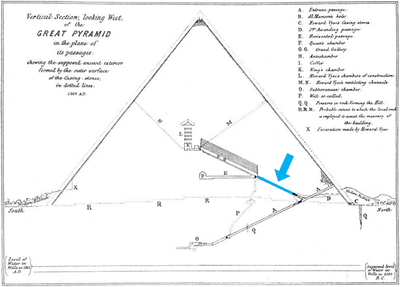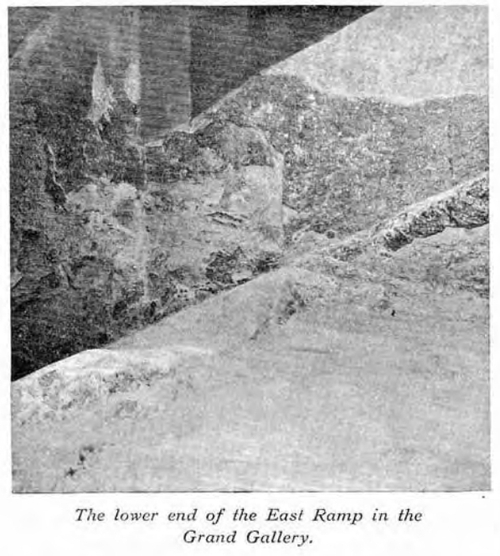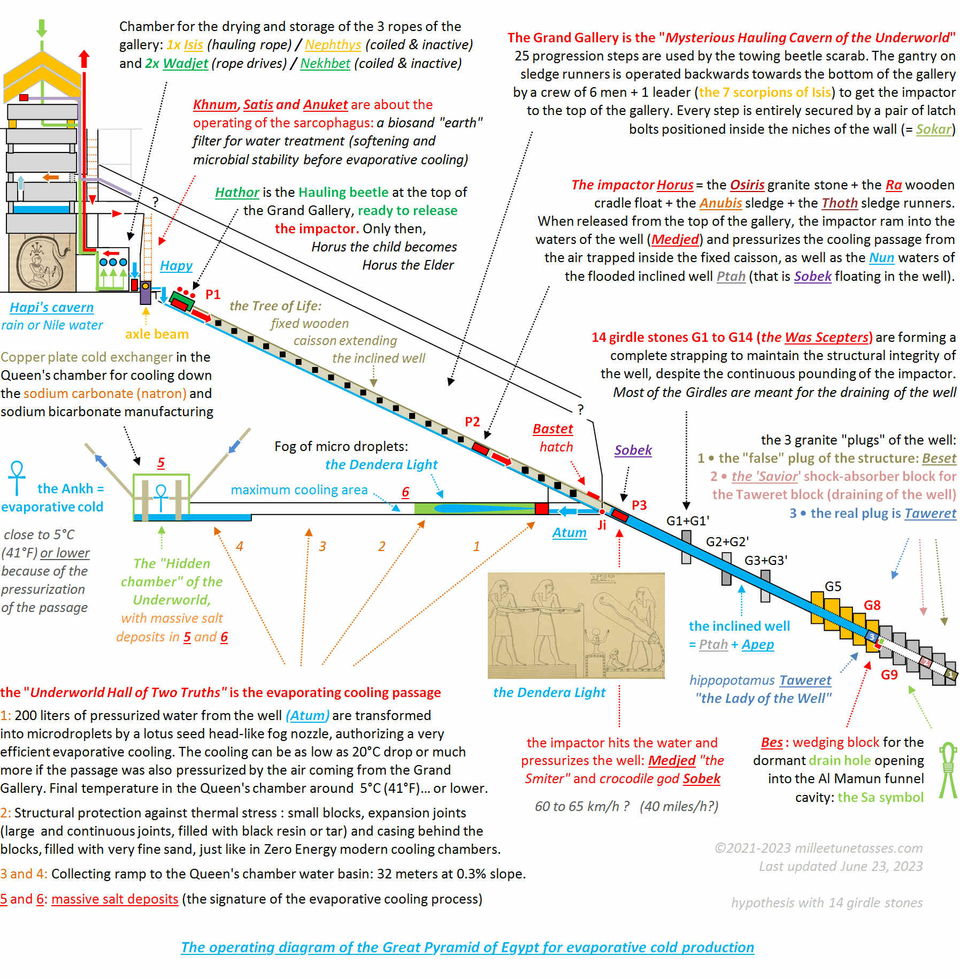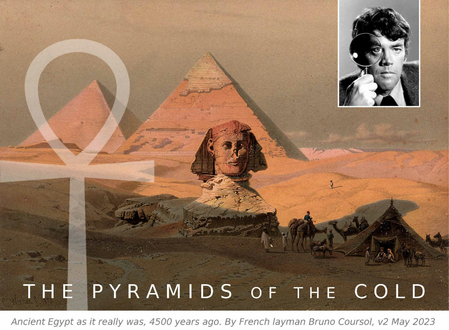- Retour accueil
- Vous êtes ici : Blog The Pyramids of the Cold v2 The Pyramids of the Cold Section 6 • The Inclined Well and the Girdles of the Great Pyramid
The Pyramids of the Cold Section 6 • The Inclined Well and the Girdles of the Great Pyramid
Publié par Bruno Coursol dans The Pyramids of the Cold v2 le 13/05/2023 à 19:25

Photograph of the ancient Egyptian way of representing the inclined well, from tomb KV 11 of Ramesses III, side chamber, image # 21076 by Matjaz Kacicnik, courtesy of ARCE, American Research Center in Egypt in partnership with the American University in Cairo Egyptology Department : https://thebanmappingproject.com/images/21076jpg
The cavity of the Caliph Al-Ma'mun, in which the water of the inclined well (the ascending passage of the Great Pyramid of Khufu) was drained into. The upper granite plug has been deified into goddess Taweret : "the Lady of the Well", the "Big One", the "Great One" and "She Who Removes Water". Photograph of the cavity of Al-Ma'mun in "Great Pyramid Passages, Volume 1, by John and Morton Edgar, 1910" : Plate LXIV, page 166 : https://archive.org/details/GreatPyramidPassagesVol11910Edition/page/n174/mode/1up
The Pyramids of the Cold v2 (May 2023) - Part B • The inclined well of the Great Pyramid of Giza
Section 6 • The inclined well layout

In summary: the structural particularities of the ascending passage, the 14 girdle stones and the interlocking polygonal arrangement of the blocks, are revealing the real function of this passage : it was designed to be flooded, exposed to repetitive shocks and to enormous pressure directed towards the exterior of the flooded well. The ascending passage was functioning as an inclined well.

The polygonal arrangement of the blocks of the ascending passage / inclined well of the Great Pyramid of Giza.
Original of the Diagram of the First Ascending Passage, by John and Morton Edgar, in "Great Pyramid Passages" 1910, plate CX, paragraph ref. 460, page 230: archive.org/details/GreatPyramidPassagesVol11910Edition/page/n239/mode/2up
6.01 The polygonal arrangement of the blocks of the ascending passage
The blocks of the first ascending "passage" are displaying an interlocking layout revealing that the so-called "passage" was actually under a lot of longitudinal forces. We'll see just now, that many huge blocks, called "girdle stones" were in addition to that, set to counteract transversal forces that were passing through the "passage", from the inside to the outside of the "passage".
With just a little more than one meter high, this passage should actually rather have been called a "conduct", and the interlocking of the blocks combined with the girdle stones should have let people know that this conduct was also (at least partially) flooded.

Vertical section, looking West, of the Great Pyramid of Giza, in the plane of its passages, by Manly Palmer Hall: https://commons.wikimedia.org/wiki/File:The_Secret_Teaching_of_All_Ages_-_Chapter_6_-_Pyramid.jpg
6.02 The "forgotten" girdle stones of the ascending passage
When you look attentively to the drawing of the Edgar brothers, showing the girdle imprints on the walls, floor and ceiling of the passage, you can see something absolutely amazing: these girdle stones were arranged in 2 sets of girdles, and that these 2 sets were positioned at a different angle to the vertical axis.
It is like the 2 sets of blocks are opening up to reveal a dormant breach. More amazing is that at the exact location where the breach is positioned, we can find a tiny squared imprint in the floor with a granite plug stuck inside; and that piece of granite is still in place today in the floor of the passage.
Contrary to what seems to suggest all the ascending passage drawings mentioning the girdle stones, there is not just 3 or 4 of these huge blocks in the passage. Actually, the entire passage, from the G4 girdle (the lower of the usual girdles) to the lower part of the passage, is nothing else than 100% girdle stones. The fact is that when the Edgar brothers tried to understand the role of these girdle blocks, they couldn't make any sense of this lower part of the passage and all these girdles. They were only interested in finding distances between blocks in order to associate these distances to Bible or other historical events. Girdle stones from G5 to G14 are completely pressed against each other. They couldn't measure anything so they didn't talk about it (this is precisely what they wrote themselves), and they didn't draw them either. And since, everybody did the exact same thing.

The layout of the girdle stones in the inclined well of the Great Pyramid of Giza (top view).
Original of the Diagram of the First Ascending Passage, by John and Morton Edgar, in "Great Pyramid Passages", (1910), plate CX, paragraph ref. 460, page 230: archive.org/details/GreatPyramidPassagesVol11910Edition/page/n239/mode/2up
6.03 The girdle stones of the ascending passage indicate that it was an inclined flooded well
In italic, are excerpts from "Great Pyramid Passages, Volume 1, by John and Morton Edgar 1910", sections 460 to 470.
Source: https://archive.org/details/GreatPyramidPassagesVol11910Edition/page/n239/mode/2up
Section 462, talking about the girdle stones: "Before leaving home we had recognized the importance of the three upper ones as marking important dates in the Law Dispensation".
Section 467: "Those Girdles which lie lower down the passage than the three just described, are all in contact with one another".
Section 468: "it would seem that the stones which form the Girdles here were originally built in solid, end to end, after which the bore of the passage was cut through them. Above the fourth Girdle, however, there can be no doubt that the passage was constructed in the usual way, i.e., that the floor was first laid, the walls erected at the proper distance apart on the floor, and the roof- stones then placed on top of the wall-stones".
The problem is that this part of the passage, from G4 to G14 is so more protected with these girdles, that it makes the usual ones look like insignificant.
If you want to understand the girdle stones layout, you need to understand that the passage was flooded and that the girdles were acting as an integrated strapping of the well.
The pressure inside the well was probably perfectly distributed on all its surface by a another complete wooden casing, that also allows the well to be waterproof. It is possible though, that the seal between the blocks was sufficient enough so that no casing was needed. Probably the center part of the floor casing part is thinner than the rest of it, and it makes a kind of gutter inside the casing allowing air and water to get out of the well, into the entry of the horizontal cooling passage.

The layout of the girdle stones in the inclined well of the Great Pyramid of Giza. Photograph of the ancient Egyptian way of representing the inclined well, from tomb KV 11 of Ramesses III, side chamber, image # 21076 by Matjaz Kacicnik, courtesy of ARCE, American Research Center in Egypt in partnership with the American University in Cairo Egyptology Department: https://thebanmappingproject.com/images/21076jpg
During the entire operating period of the Great Pyramid, the bottom of the inclined well was sealed by the Taweret block : the upper granite plug. Taweret was maintained in position by a wedging block presenting an easy to break protruding part, getting out of the floor of the well. The breaking of that fragile part released the Taweret block and the waters of the well were drained through the dormant breach, between the Girdle Stones G8 and G9.
6.04 The lower end-to-end girdles are arranged in 2 sets with different orientations
When you look attentively to the drawing of the Edgar brothers (plate CXXVIII), showing the girdle imprints on the floor of the passage (red and green short lines), you can see something absolutely amazing: these girdle stones were arranged in 2 sets of girdles, and that these 2 sets were positioned at a different angle to the vertical axis.
This particular layout reveals a dormant breach, just waiting to be opened up, and it is located right where the Al Ma'mun cavity has been digged.
6.05 The breach opening for the shutdown procedure of the pyramid
The 2 sets of girdles with different orientations are opening up to reveal a dormant breach. More amazing is that at the exact location where the breach is positioned, we can find a tiny squared imprint in the floor with a granite plug still stuck inside, and on the other side of the wall is the huge Al-Ma'mun cavity, leading to the subterranean part of the Great Pyramid.
My guess is that this particular layout was designed to drain the well for the shutdown procedure of the pyramid : a small granite block would have been positioned in the small imprint (colored in blue on the drawing), placed against the wall, directly next to the dormant breach.
This is Petrie talking about the part just ahead (south) of the granite plugs: "The present top one is not the original end ; it is roughly broken, and there is a bit of granite still cemented to the floor some way farther South of it". Source: The Pyramids and Temples of Gizeh par W. M. Flinders Petrie. Chapter : Ascending Passage, page 21.
When time has come to shut the pyramid down, the impactor is lifted up to the top of the grand gallery one last time, unless this time there is no float anymore. When the impactor is released and enter the inclined well, it doesn't pop back up to the surface but sink to the bottom of the well with high velocity. When it hits the granite plug block n°3 that was dormant all along by this small granite block in the imprint, it opens the breach and all the water is drained trough the cavity of Al-Ma'mun.
The draining of the well was necessary in order to empty completely the pyramid of all its content. More about it farther below, same post (dormant breach, little imprint, draining of the well into the cavity of Al-Ma'mun...).

"The iron grill door which closes the lower reach of the descending passage of the Great Pyramid of Gizeh; showing Judah sitting on the debris which concealed Petrie's granite block; also the lower butt-end of the Granite Plug which blocks the entrance of the First Ascending Passage." Plate LXVI, page 170 in "Great Pyramid Passages, Volume 1, by John and Morton Edgar": archive.org/details/GreatPyramidPassagesVol11910Edition/page/n177/mode/2up?view=theater
6.06 The Eyes looking through the magnifying glass… and at the lower butt end of the granite plug
We've already seen that the Eye of Horus represented on the "Moon" and worshiped by Science god Thoth, was actually about an eye looking through a magnifying glass; here there is another example of the use of the Eye of Horus, to express the simple idea of "visibility": you can look through the magnifying glass and you can have a look at the bottom of the structure represented on the left image.
Even if the relief from the tomb of Rameses III is still mysterious in many ways, it evidently is about the inclined well and the sequential ejection of pressurized water: the blue "dots" in the inclined "tube", and the snake "sneaking out" of the tube, they are all about water.
Because it is about the inclined well of the Great Pyramid, the Eyes of Horus represented at the bottom of the whole thing, are about the lower granite plug of the "ascending passage": this granite block was the only visible part of the whole structure in which the inclined well was built in (most probably this block has been deified into Beset, because just like Bes, and contrary to both Taweret and the Savior block, this particular block wasn't supposed to move an inch, ever; Bes and Beset, because of the similarity of their names, were most probably both about "not moving an inch", even if Bes had been designed to break under a certain amount of pressure).
The photograph of Judah, who helped the Edgar brothers in 1909, is thereon particularly striking, because it is the perfect modern illustration of these Eyes of Horus: Judah is doing the exact same thing by looking at this strange and beautiful granite block. In short, Judah here is looking right at Beset.

6.07 The Junction imprint between the inclined well and the horizontal cooling passage
the Junction imprint was connecting the inclined well waters with the horizontal evaporative cooling passage. Without it, there wouldn't be any pressurized water ejected from the inclined well towards the evaporative cooling passage.
This little imprint was absolutely essential once the wooden ramp would have been in place.
6.08 The only known photograph of the Junction imprint ?
Image of the Junction imprint, taken by John and Morton Edgar and published in "Great Pyramid Passages Vol 1, 1910 edition", plate CXLIX, page 274: https://archive.org/details/GreatPyramidPassagesVol11910Edition/page/n283/mode/2up

The only image of the Junction imprint that I was lucky to find, has been taken by John and Morton Edgar and published in "Great Pyramid Passages Vol 1, 1910 edition", plate CXLIX, page 274.
Excerpt from "Great Pyramid Passages": "Our photograph of this lower part of the East Ramp where it butts against the north wall of the Grand Gallery (Plate CXLIX), shows also the abrupt cut-off of the smooth sloping floor, a short distance up (south) from the line of the north wall of the Gallery."
It looks like the floor of the ascending passage has been pretty rapidly covered with wooden boards to facilitate the tourists' progression in the passage, and that the Junction imprint in now hidden underneath.
It is also possible that it had been filled up with cement, like it had been done in the cut-off of the top platform of the Grand Gallery.

Statue of god Ptah, photographed by kairoinfo4u: flickr.com/photos/manna4u/26774477850/in/photostream/
"Ptah, in the form of a mummified man (except for arms and face) standing on the symbol for Ma'at, holding a scepter or staff that bears the combined ankh-djed-was symbols" and drawing of the Creation god Ptah by Jeff Dahl on Wikipedia: https://en.wikipedia.org/wiki/Ptah
Photograph from tomb KV 11 of Ramesses III, side chamber, image # 21076 by Matjaz Kacicnik, courtesy of ARCE, American Research Center in Egypt in partnership with the American University in Cairo Egyptology Department: https://thebanmappingproject.com/images/21076jpg
6.09 Ptah's hollow scepter is a representation of the inclined well itself
In the above image and in most of his representations, Ptah is holding a blue and yellow scepter or staff that bears the combined ankh, djed and was symbols.
This blue and yellow 'staff' is actually the representation of the inclined well of the pyramid, and the reason why the ankh, djed and was symbols seem to be nested into that 'staff' is only to indicate that it is hollow: the 'staff' is the inclined well and the dotted blue line is about the movement of water .
The representation of the well held by Ptah is always in a perfect vertical position, but its true nature is shown in the tomb of Ramesses III: it has pretty much the same slope than the Grand Gallery/ascending passage layout.
6.10 Ptah constantly referring to the Heart is the glorification of the Heart of the Pyramid: the inclined well
We've already seen many times that the inclined well was metaphorically represented into a functioning beating heart, so when creator god Ptah is constantly referring to the Heart, he is referring to the inclined well.
In the following excerpt, Ptah is being linked to some of the ancient Egyptian gods that are referring to the evaporative cooling process: Atum and Tefnut ('tf' meaning to spit).
Of course, the mention of the tongue in the following excerpts is directly referring to the ejection of the small amount of pressurized water (that is Atum): the "tongue" reference is about spitting.
"He created the universe by speaking words through his Tongue (linked to the god Thoth and the goddess Tefnut) and by thoughts coming from his Heart [...]. There came into being as the heart and there came into being as the tongue ... in the form of Atem (Atum)." http://www.touregypt.net/featurestories/ptah.htm
6.11 The creation of the myths about the inclined well
It is very hard to imagine what really looked like the pyramid when operated, but certainly as I've already discussed many times in posts previous to 'The Pyramids of the Cold', the Great Pyramid wouldn't have been completed; it would have pretty much looked like the lower part of the Bent Pyramid, and if this Bent Pyramid is precisely in 2 parts, it must certainly has to be related to that lower Great Pyramid part for cold production.
But if the impactor hit the waters of the well every 15 minutes and if the Grand Gallery was somehow close to be in midair, the sound of the whole thing would have been heard probably kilometers away.
Everybody in ancient Giza would have been able to hear it, 10 hours a day, every 15 minutes for most probably a period of 4 months. Residents of Giza would have heard it but also everybody coming to Giza from foreign countries: visitors, merchants, domestic and foreign dignitaries, etc.
Of course, the biggest impression would have been caused by the breaking of the Bes wedging block and the release of the Taweret block resulting in the tremendous shock with the Savior block (granite plug #2).
Everybody heard it, and everybody talked about it. This is how the inclined well inspired so many myths in the ancient World.

Diagram of the operating Great Pyramid of Egypt for evaporative cold production (hypothetically for chemical manufacturing cooling of pure sodium carbonate "natron", the salt used for the mummification of pharaohs). When in operation, the elevation of the Great Pyramid was not finished, and it is only after the shutdown procedure and the draining of the inclined well, that the 3 granite plugs were finally close to one another.

The Pyramids of the Cold version 2 (May 2023 - May 2024)
Summary of the study and Table of Contents
Part A: The evaporative cooling process
Section 1 • The horizontal evaporative cooling passage layout
Section 2 • The Dendera Light and the creation of the fog of microdroplets by the fog nozzle
Section 3 • The water cycle glorifying metaphors: Geb, Shu, Nut, Tefnut
Section 4 • The theorization of the evaporative cooling process by Akhenaten and Nefertiti
Section 5 • The theorization of the evaporative cooling process in the Weighing of the Heart
Part B • The inclined well of the Great Pyramid of Giza
Section 6 • The inclined well layout and the girdle stones
Section 7 • The Taweret "Lady of the Well" temporary sealing granite plug of the well
Section 8 • The Bes temporary wedging block immobilizing Taweret
Section 9 • The draining of the well
Section 10 • The Great Serpent Apep and the snake water metaphors
Section 11 • The Was scepter and the control over "snakes"
Section 12 • The beating Heart of the Great Pyramid
Part C • The composite impactor of the Great Pyramid (Horus, Ra, Osiris, Medjed, Sobek...)
Section 13 • The wooden and stone composite design of the impactor: Ra and Osiris
Section 14 • The endlessly immersed Osiris stone and the seed metaphor
Section 15 • The Anubis sledge and the bobsled mask
Section 16 • The sledge runners of the impactor: Thoth
Section 17 • Medjed: the smiter nobody can ever see
Section 18 • The Apis bull and the ramming impactor's metaphors
Section 19 • The crocodile god Sobek impactor (more or less) floating in the waters of the well
Section 20 • The Obelisk and the Benben stone rising from water
Part D • The Grand Gallery's of the Great Pyramid of Giza
Section 21 • The Sacred "sloping paths" of the "oval-shaped cavern of the act of Hauling"
Section 22 • The central wooden caisson of the Gallery: Sekhmet and the Triad of Memphis
Section 23 • The hauling ropes of the Grand Gallery: Isis, Nephthys, Hatmehit, Wadjet and Nekhbet
Section 24 • The hauling Beetle and the Seven Scorpions of Isis
Section 25 • The Great Cow goddess Hathor and the operating cycle of the hauling Beetle
Section 26 • The 10 operating phases of the Grand Gallery
Section 27 • The guide to the Afterlife for the smart traveler and the canopic jars
Section 28 • The scarab amulet glorifications of the hauling Beetle
Part E • The very large and roughly finished sarcophagus of the Great Pyramid
Section 29 • The biosand filter sarcophagus of the Great Pyramid
Section 30 • The Elephantine Triad deification of the biosand filter of the Great Pyramid
Section 31 • The Great Pyramid's operating flat roof and the water supply issue
Part F • Chemical manufacturing and industrial cooling before the Great Pyramid
Section 32 • The Serdab and the "Refreshment of the Gods" Step Pyramid of Djoser
Section 33 • Sneferu's Red Pyramid and the accumulated ammonia
Section 34 • The Disc of Sabu and the Solvay process for pure natron manufacturing
Part G • The tremendous impact of the Great Pyramid on the whole ancient world
Section 35 • The hidden secrets of the Hermetica Emerald Tablet (around 1600 C.E.)
Section 36 • Thor and the magical Hammer in the Great Hall of Bilskirnir
Section 37 • The Churning of the waters of the Ocean of Milk (Hindu mythology)
Section 38 • The Tibetan prayer wheels and the Grand Gallery's operation
Section 39 and Conclusion • The cooling water of spitting Kebechet
Part H • Epilogue
Section 40 • The smiting Ark of the Covenant and the Ten Commandments
Section 41 • The 293 kilograms windlass Staff of Moses and Aaron... and the First Plague of Egypt: water turning into blood
Section 42 • Ezekiel's Four Egyptian pulley "Wheels within the Wheels" and the four angel ropes
Section 43 • David, Saul, two giant Goliaths, five little stones, an aeolian harp... and a weaver's beam
Section 44 • The holy water fonts and the biosand filter
Part I • The magicians of the Great Pyramid of Giza
Section 45 • The Legend of Khufu and the "magician" polymath Imhotep
Section 46 • The two magical eyes of Isis and the brilliant but painful flame of her twin sister's braids
Section 47 • The Aegis Shield of Athena "Subduer of the Winds" and the upper hatch of the central wooden caisson
Section 48 • The Seven Magical Words spoken by 'Divine Sealer' Goddess of Arrows and Bronze Neith
Poster un commentaire
